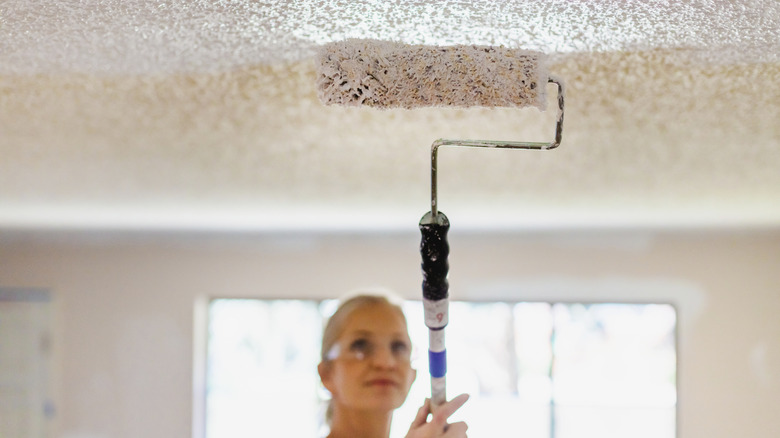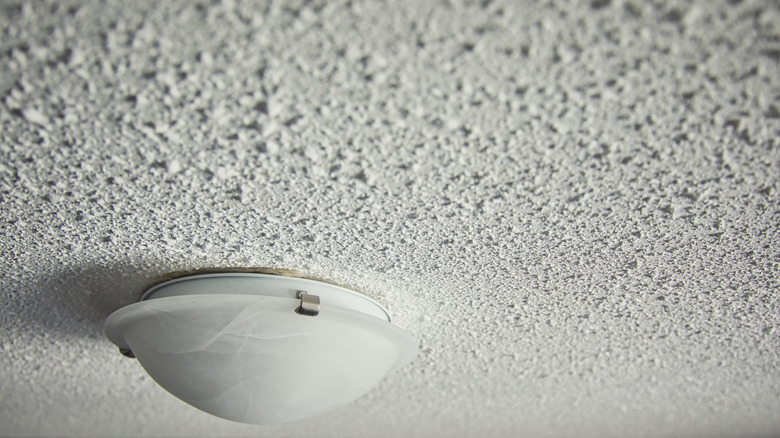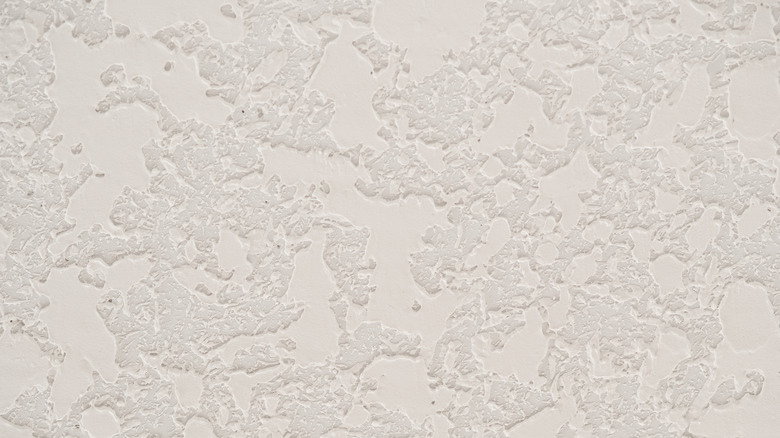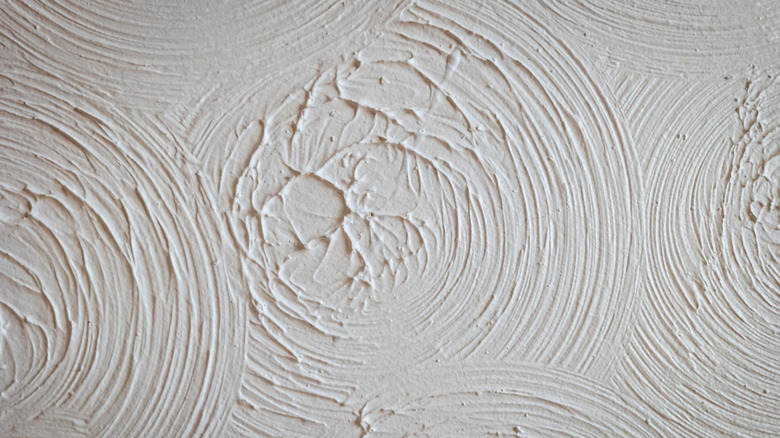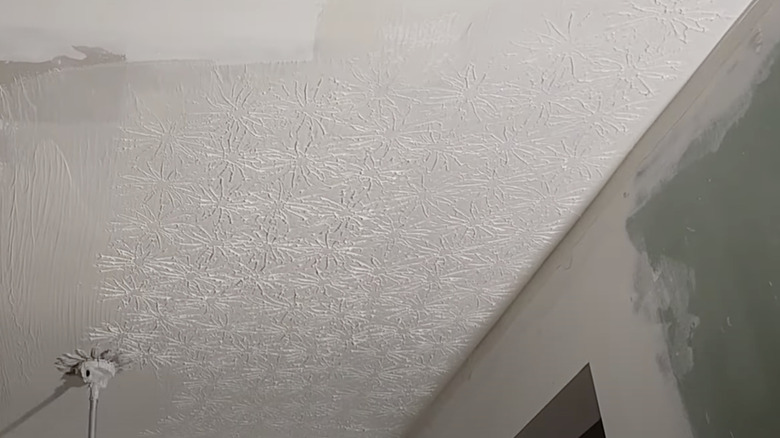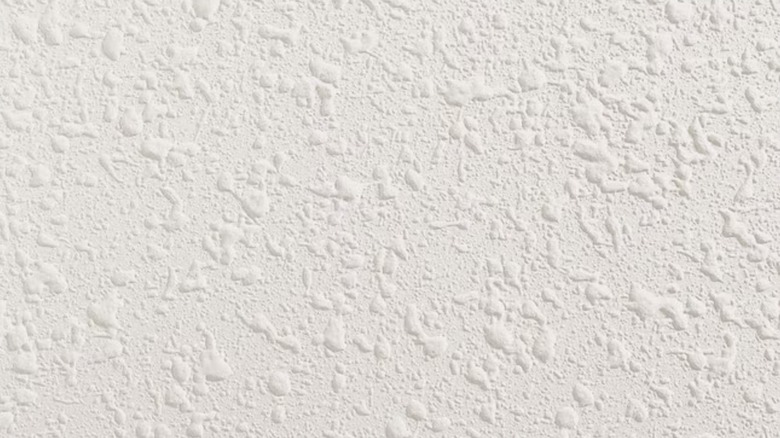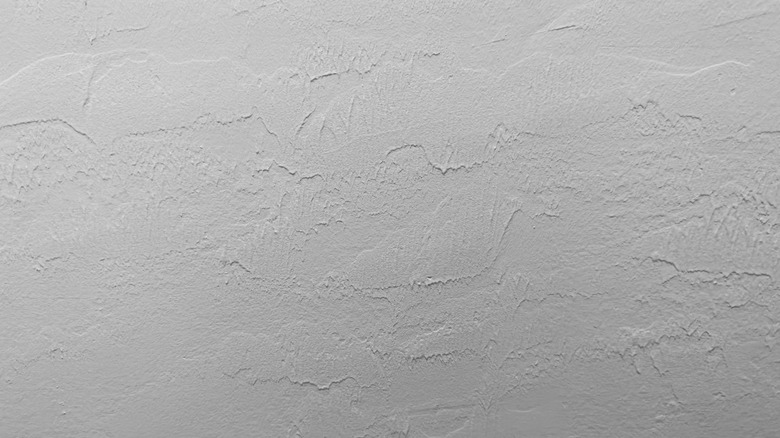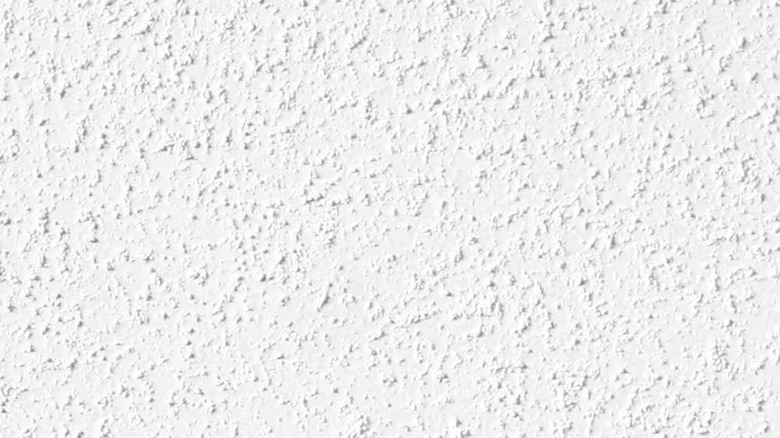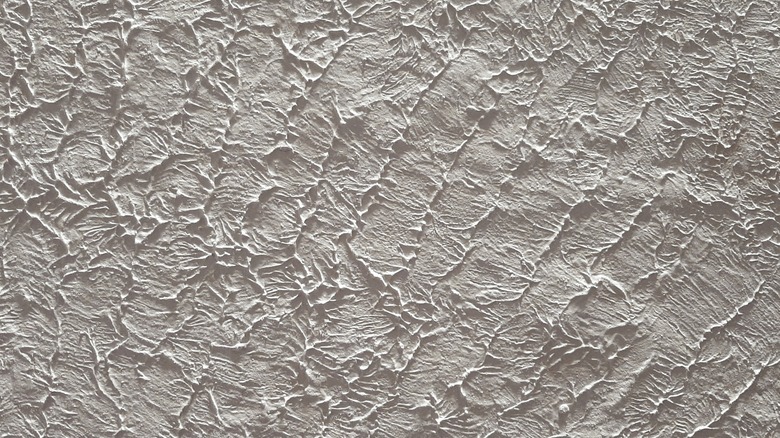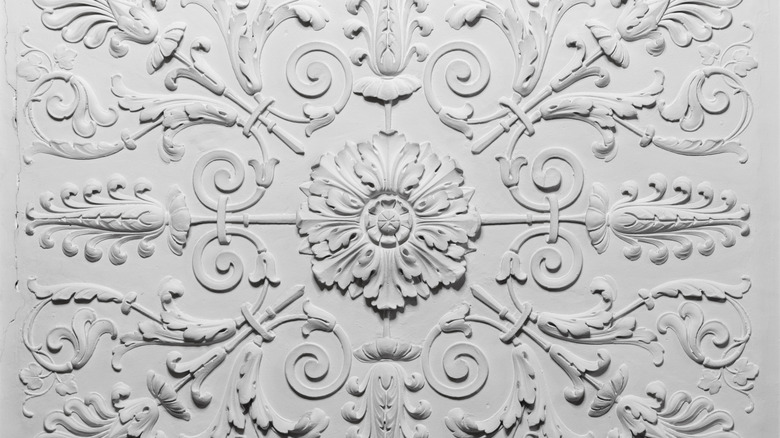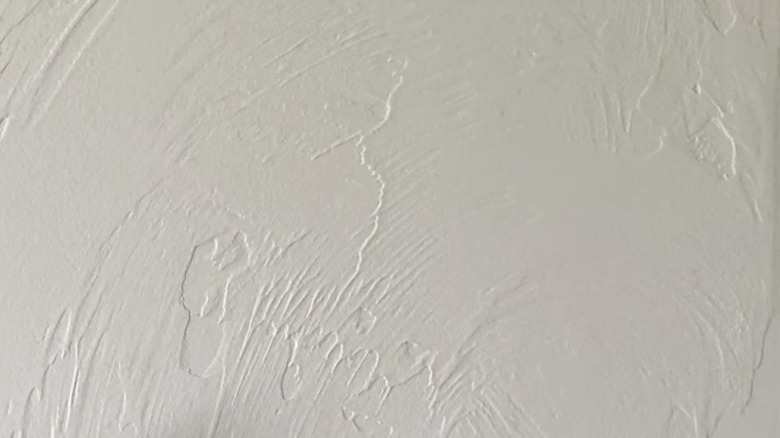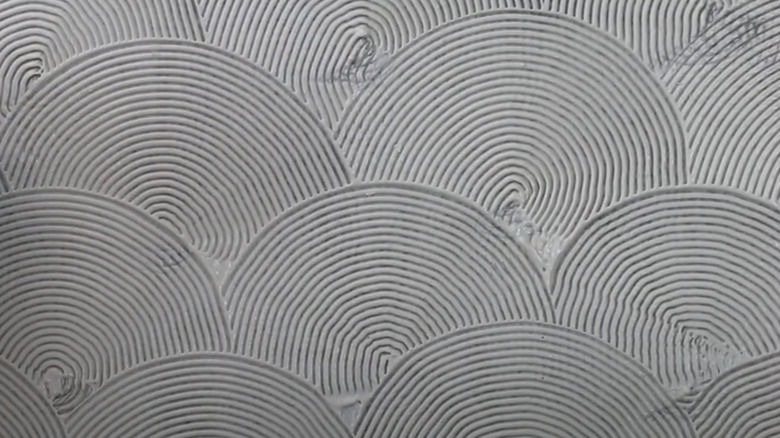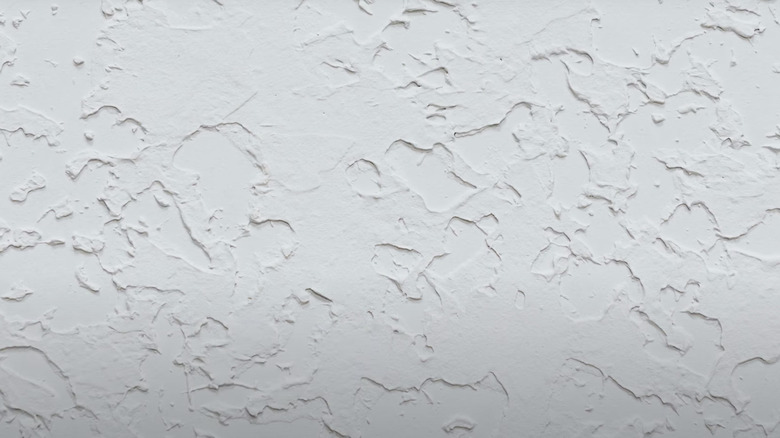The 12 Best Ceiling Textures That Reduce Noise In Your Home
We may receive a commission on purchases made from links.
Made primarily from joint compound, ceiling textures are used for a variety of aesthetic and acoustic reasons. When your ceiling finish is uneven, dated, or even damaged, these textures add depth while hiding imperfections like joints or stains. They're also a cheaper solution than soundproofing panels or installing a drop ceiling if high ceilings, rambunctious kids, or raucous gatherings turn your living room into the loudest spot in the house. Popcorn, stomp, and knockdown ceiling textures are extremely common in builder grade homes, but elaborate swirls, fans, and hand brocade designs are just a few of the other ceiling textures that reduce noise in your home.
Between the TV blaring out your favorite shows and the dog barking at the Amazon delivery guy, too much noise can quickly turn conversation into clamor. When you add incidental noises to the mix, like the sound of someone kicking off their shoes or chairs sliding out from under the table, it doesn't take long for calm to turn into chaos. That's where the best ceiling textures come into play. They don't just change how a room looks — they change how it sounds.
Although smooth ceilings are becoming more popular, the trend comes with a serious tradeoff. They reflect sound instead of softening it. Opting for a unique ceiling texture created from noise dampening joint compound layered over drywall absorbs and diffuses sound waves while also reducing echo and reverb. They're the perfect solution if you want more peace and quiet in your space.
Popcorn texture
Popcorn ceilings are one of the most controversial textures out there. Commonly used until the late 1990s, the sprayed-on texture does an excellent job of reducing noise because each "kernel" creates a rough surface that disrupts sound waves. There are some hidden downsides of popcorn ceilings you should be aware of before committing to the look. The spray-on texture can be difficult to clean, and when it's old, it may contain asbestos. However, popcorn ceiling texture is among the best choices if you want to hide imperfections in your ceiling or you're looking for an easy installation process.
Knockdown texture
Knockdown ceiling texture is another popular choice, especially in new homes or renovations where concealing flaws is a factor. The mottled look is achieved by spraying watered down compound on a ceiling, allowing it to set slightly, and then using a plastic blade like the ROLLINGDOG 12 Inch Knockdown Knife from Amazon to flatten any drips. It takes a little practice to smooth out only the peaking portions of the compound instead of flattening it altogether. If you plan to DIY this ceiling texture, try practicing on a piece of cardboard first.
Swirl texture
When you want your ceiling texture to stand out, consider the swirl. The right method depends on the exact aesthetic you're trying to achieve. Once again, you'll start with a slightly thinned out joint compound that spreads easily. Make sure it isn't too drippy, especially if you want well defined swirls. Then, use a stiff brush or a sponge to create full or semicircles. Experiment with different pressures and movements until you get it exactly right. Make sure you don't overwork the compound, and stand back occasionally to make sure the effect is consistent across the entire ceiling.
Stomp texture
Stomp brush ceilings are another older texture technique that stands the test of time because it's so simple. First, you'll apply your drywall mud to the ceiling. Then, you'll quickly take a soft texture brush with long bristles (like the highly rated Magnolia Brush Single Round) and push it straight into the compound before pulling it straight back down. This is one of the best ceiling textures if you're new to finishing ceilings, you need something that hides imperfections, or you're trying to match an existing ceiling texture on an older home.
Orange peel texture
Orange peel ceiling texture is a slightly rough, pebbled surface created using either drywall compound, plaster, or a water-based aerosol product. It's popular for ceilings because the subtle bumps add just enough visual interest while offering an uneven textured surface that diffuses sound and reduces echo. Plus, because it's relatively smooth compared to stomp brush and popcorn textures, orange peel ceiling texture is easier to clean. Remember to work in a properly ventilated space if you opt for an aerosol application.
Skip trowel texture
If you love the look of stucco, you may want to consider a skip trowel texture for your ceilings. To achieve it, you'll apply joint compound by hand before using a tool like the Goldblatt Stainless Steel Pool Trowel from Amazon to create thin, irregular layers. Thoroughly mixing coarse sand into the compound like Rust-Oleum Sand-Tex Additive will give it more body, which is ideal if you want thicker ridges that stand out.
Spray sand texture
Speaking of sand, there are a couple of different ways to achieve a subtle spray sand texture on your ceiling. To get the look, you can simply roll on a textured finishing product, but if your arms and back ache at the thought and you'd rather use a sprayer, some drywall pros recommend mixing a bag of sand directly into water or primer before spraying it through the smallest hole on your hopper. This will ensure the look stays extremely fine instead of veering into orange peel sized bumps.
Slap brush texture
When it comes to common ceiling textures that reduce noise, slap brush and stomp brush are often used interchangeably. Popular not just because it's so easy to do but because it's easy to repair if your ceiling ever starts to show signs of a leak or wear and tear, the stippled effect all comes down to technique. The difference between "stomping" and "slapping" the ceiling is all in the application. Where stomping leaves thick and irregular ridges, slapping will achieve thinner ridges on trend with today's more modern ceilings.
Floral texture
When you want to give your space a whole new look with a stunning statement ceiling instead of applying a texture designed to fade into the background, try incorporating floral patterns. The process is similar to the knockdown effect, although stencils or special rollers like the Nichiyo Patterned Embossing Rubber Roller are often used instead of a flat blade to create consistent patterns. Unlike other ceiling textures on our list, which are relatively easy to achieve even as a first-time DIYer, you may want to enlist the help of a professional, especially if you want an ornate design.
Santa Fe texture
Santa Fe ceiling texture is very similar to the skip trowel effect. Popular in the southwestern United States, when properly applied it looks like two layers of drywall on top of each other, where the lower layer peeks through in certain areas. The main difference between the two styles is the amount of coverage. Santa Fe textures are much smoother and lower-profile, with a higher amount of top layer coverage. It also doesn't typically have any circular shapes within the application.
Fan pattern texture
Not unlike the swirl pattern, a fan ceiling texture is created by applying a thick layer of joint compound before creating the distinct arching shapes. Instead of using a brush or sponge, which tend to create slightly irregular shapes, precision helps the fan pattern texture truly stand out. You can achieve it by using a tool like the MARSHALLTOWN Plastic Notch Flooring and Tiling Spreader. Starting on one side of your ceiling, make a series of slightly overlapping semicircles in a row. Continue the process until your ceiling is covered in elegant textured ridges that muffle sounds.
Hand brocade texture
Hand brocade textures are accomplished using the same method as a knockdown textures. But it's a more dramatic look thanks to the larger variation in the depth of the ridges. This is the result of applying thick drywall compound by hand. Because hand brocade relies on heavy layering, you can hide any mistakes by simply adding more drywall compound. This makes hand brocade ceiling texture ideal for beginners. Even professional drywall installers say it's almost impossible to mess it up!
